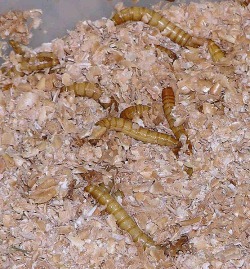Loading
Making the Most of the Mealworm: some tips on enhancing the nutritional value of this pet trade staple
WRITTEN BY: Frank Indiviglio
ThatReptileBlog
ThatReptileBlog
Hi, Frank Indiviglio here. Today I’d like to take a look at a much-maligned food insect that can, if used properly, be an important addition to your pets’ diets.
Mealworms (larvae)
A steady diet of mealworms (I refer here to the small mealworm, Tenebrio molitor, not the giant mealworm, Zophobus mario) is not recommended for any reptile or amphibian. These beetle larvae lack essential nutrients, the calcium: phosphorus ratio is not ideal and the exoskeleton is high in chitin. Mealworms also have quite strong jaws, and may injure debilitated or small reptiles and amphibians.
However, newly molted mealworms, which are white in color, are soft, have weak mouthparts and lower chitin levels. I have found them to be an excellent supplementary food for amphibians, tarantulas, scorpions and reptiles and fish.
Mealworms will shed most frequently when fed heavily and kept at 76-80 F. I house my colony in a mix of wheat bran, corn meal and powdered multi-grain baby food, with a bit of Tetramin Flake Fish Food added in, and provide banana skins for moisture.
Mealworm Pupa
Mealworm pupae are a fine food for turtles, newts, aquatic frogs and those lizards that accept non-living food items. They are low in chitin and likely have a different nutrient profile than either the larvae or adults.
Mealworm (Darkling) Beetles
Beetles, comprising the world’s largest animal family, figure prominently in the diets of most insectivorous reptiles and amphibians (based upon stomach content studies). I have long used darkling beetles (adult stage of the mealworm) as a food item, and prefer them over the larvae in most situations.
Beetles newly emerged from the pupae are softer than later-stage animals, and brown in color. To ensure a steady supply, I remove pupae as they form and place them into a bare container. In this way the beetles cannot burrow into the substrate, and are thus easier to harvest. Warm temperatures and a good diet (see above) will ensure a steady supply. Be sure to leave some beetles in the colony for breeding purposes.
Please write in with your own tips and questions. Thanks, until next time, Frank.
You can learn more about the specifics of the mealworm’s life cycle at:
http://lawrencehallofscience.org/foss/fossweb/teachers/materials/plantanimal/tenebriobeetles.html
Image referenced from Wikipedia: http://en.wikipedia.org/wiki/Image:Mealworms_in_plastic_container_of_bran.jpg

